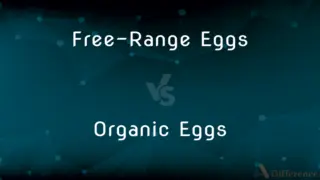Nikon D5100 vs. Nikon D5200 — What's the Difference?
By Tayyaba Rehman & Urooj Arif — Published on February 15, 2024
Nikon D5100 is a mid-range DSLR with a 16.2MP sensor, while Nikon D5200 offers a higher resolution with a 24.1MP sensor, both catering to advanced amateurs.

Difference Between Nikon D5100 and Nikon D5200
Table of Contents
ADVERTISEMENT
Key Differences
The Nikon D5100 and Nikon D5200 are both digital single-lens reflex (DSLR) cameras designed for the advanced amateur photographer market. While they share many features, including the ability to interchange lenses and utilize Nikon's F-mount system, there are key differences that set them apart. The Nikon D5100, introduced in 2011, features a 16.2-megapixel DX-format CMOS sensor. Its successor, the Nikon D5200, was launched a year later with a significant upgrade to a 24.1-megapixel sensor, offering higher resolution for more detailed images.
Both cameras come equipped with a vari-angle LCD screen, allowing for flexible shooting angles. However, the D5200's screen boasts a slightly higher resolution, enhancing the clarity and detail when composing shots or reviewing images. The autofocus system in the D5200 also received an upgrade, moving from the 11-point autofocus system in the D5100 to a more advanced 39-point system in the D5200, improving accuracy and tracking performance, especially in dynamic shooting situations.
In terms of performance, both cameras offer a range of ISO settings suitable for various lighting conditions, but the D5200 extends the ISO range further, offering better low-light performance without compromising image quality. The D5200 also features a faster continuous shooting rate, making it more suitable for capturing fast action shots compared to the D5100.
While both cameras support full HD video recording, the D5200 introduces enhancements in video functionality, including a built-in stereo microphone for improved audio recording. This makes the D5200 a more versatile choice for photographers looking to also capture high-quality video content. Despite these differences, both cameras maintain the user-friendly interface and creative modes that Nikon is known for, making them accessible to photographers of varying skill levels.
Comparison Chart
Sensor Resolution
16.2 megapixels
24.1 megapixels
ADVERTISEMENT
Autofocus System
11-point AF system
39-point AF system
ISO Range
100-6400 (expandable to 25600)
100-6400 (expandable to 25600)
LCD Screen Resolution
921,000 dots
1,037,000 dots
Continuous Shooting Speed
4 fps
5 fps
Video Recording
Full HD 1080p
Full HD 1080p with built-in stereo mic
Launch Year
2011
2012
Compare with Definitions
Nikon D5100
Offers ISO range up to 25600 for low-light photography.
Night landscapes come out great with the D5100's high ISO capabilities.
Nikon D5200
Features a slightly higher resolution LCD screen.
Reviewing photos on the D5200's sharp screen is a joy.
Nikon D5100
Records full HD 1080p video.
Filming my sister's wedding with the D5100 was a breeze.
Nikon D5200
Upgraded to a 39-point autofocus system.
Sports photography is easier with the D5200's superior AF system.
Nikon D5100
A 16.2MP DSLR camera with vari-angle LCD.
The Nikon D5100's flip-out screen is perfect for shooting videos.
Nikon D5200
Enhances video with a built-in stereo microphone.
My travel vlogs sound great thanks to the D5200's stereo mic.
Nikon D5100
Launched by Nikon in 2011 for advanced amateurs.
The D5100 was my upgrade choice for its advanced features at an amateur level.
Nikon D5200
A 24.1MP DSLR with an improved sensor.
The Nikon D5200's high resolution makes my photos incredibly detailed.
Nikon D5100
Features 11-point autofocus system.
I captured a sharply focused bird in flight using my D5100.
Nikon D5200
Introduced by Nikon in 2012 with enhanced features.
I chose the D5200 for its latest tech advancements in the Nikon lineup.
Common Curiosities
Can I use the same lenses on both the D5100 and D5200?
Yes, both cameras are compatible with Nikon's F-mount lenses.
Are the D5100 and D5200 suitable for beginners?
Yes, both are user-friendly and suitable for photographers at different skill levels.
Which camera is better for low-light photography?
Both offer the same ISO range, but the D5200's newer sensor may provide slight improvements.
Can I shoot sports effectively with the D5100 or D5200?
The D5200's faster AF system and continuous shooting speed make it more suited for sports.
Which camera would you recommend for wildlife photography?
The D5200, due to its superior autofocus system and higher resolution.
Is there a difference in video quality between the D5100 and D5200?
Both support 1080p, but the D5200 has a built-in stereo mic for better audio.
Do both cameras have a vari-angle LCD screen?
Yes, both feature a vari-angle LCD for flexible shooting angles.
What is the main advantage of the D5200 over the D5100?
Higher resolution, better autofocus system, and enhanced video capabilities.
Which camera has a higher resolution, D5100 or D5200?
The D5200 with a 24.1MP sensor.
How do the continuous shooting speeds compare?
The D5200 offers 5 fps, slightly faster than the D5100's 4 fps.
Do both cameras offer manual controls?
Yes, both provide full manual controls alongside automatic modes.
Can the D5200's higher resolution affect file sizes?
Yes, higher resolution images will take up more storage space.
Which camera offers more value for an advanced amateur?
The D5200, with its enhanced features, offers more value for those looking to advance their photography skills.
Is the image quality significantly better in the D5200?
The D5200 offers higher resolution, which can result in more detailed images.
Are the D5100 and D5200 good for travel photography?
Yes, both are versatile and compact enough for travel.
Share Your Discovery

Previous Comparison
Free-Range Eggs vs. Organic Eggs
Next Comparison
Overweight vs. ObeseAuthor Spotlight
Written by
Tayyaba RehmanTayyaba Rehman is a distinguished writer, currently serving as a primary contributor to askdifference.com. As a researcher in semantics and etymology, Tayyaba's passion for the complexity of languages and their distinctions has found a perfect home on the platform. Tayyaba delves into the intricacies of language, distinguishing between commonly confused words and phrases, thereby providing clarity for readers worldwide.
Co-written by
Urooj ArifUrooj is a skilled content writer at Ask Difference, known for her exceptional ability to simplify complex topics into engaging and informative content. With a passion for research and a flair for clear, concise writing, she consistently delivers articles that resonate with our diverse audience.













































